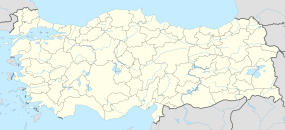Mopsuestia
| Μοψουεστία | |

Roman bridge in Misis-Mopsuestia over the Pyramus
|
|
| Alternate name | Mopsos, Seleucia on the Pyramus, Hadriana, Decia, al-Maṣṣīṣah, Mamistra, Misis, Yakapınar |
|---|---|
| Location | Adana Province, Turkey |
| Region | Cilicia |
| Coordinates | 36°57′28″N 35°37′26″E / 36.95778°N 35.62389°ECoordinates: 36°57′28″N 35°37′26″E / 36.95778°N 35.62389°E |
| Type | Settlement |
Mopsuestia (Greek: Μοψουεστία Mopsou(h)estia; Byzantine: Mamista, Manistra; Arabic: al-Maṣṣīṣah; Armenian: Msis, Mises, Mam(u)estia; Frankish: Mamistra), is an ancient city in Cilicia Campestris on the Pyramus River (now Ceyhan River) located approximately 20 km (12 mi) east of ancient Antiochia in Cilicia (present-day Adana, southern Turkey). From the city’s harbour the river is navigable to the Mediterranean Sea, a distance of over 40 km (24 mi).
The founding of this city is attributed in legend to the soothsayer, Mopsus, who lived before the Trojan war, although it is scarcely mentioned before the Christian era. Pliny the Elder calls it the free city of Mopsos (Hist. nat., V, 22), but the ordinary name is Mopsuestia, as found in Stephanus of Byzantium and all the Christian geographers and chroniclers. Under the Seleucid Empire, the city took the name of Seleucia on the Pyramus (classical Greek: Σελεύκεια πρὸς τὸν Πύραμον, Seleukeia pros ton Pyramon; Latin: Seleucia ad Pyramum), but gave it up at the time of the Roman conquest; under Hadrian it was called Hadriana, under Decius Decia, etc., as we know from the inscriptions and the coins of the city. Constantius II built there a magnificent bridge over the Pyramus (Malalas, Chronographia, XIII; P.G., XCVII, 488) afterwards restored by Justinian (Procopius, De Edificiis, V. 5) and has been restored again recently.
Christianity seems to have been introduced very early into Mopsuestia and during the 3rd century there is mention of a bishop, Theodorus, the adversary of Paul of Samosata. Other famous residents of the early Christian period in the city’s history include Saint Auxentius (d. 360), and Theodore, bishop from 392–428, the teacher of Nestorius. The bishopric is included in the Catholic Church's list of titular sees. Along with much of Cilicia, the region was wrested from Roman control by the Arabs in the late 630s.
...
Wikipedia

